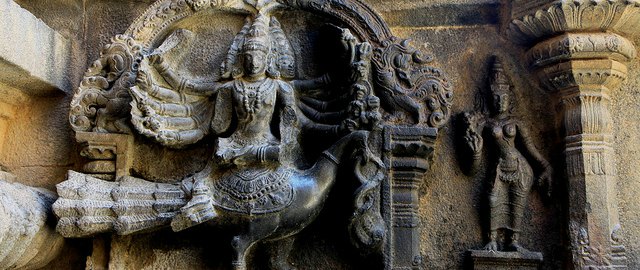
Thanjavur Temple
We had heard that if someone asks to see just one temple in Tamil Nadu that epitomizes everything about the state’s glorious history and culture, then it has be this grand specimen in the town of Thanjavur. Also, along with Chidambaram, the Thanjavur temple was always on my list of must-visit temples because of its association with Bharatanatyam. So I was quite excited when we headed out from Kumbakonam in a hired taxi to visit the Thanjavur Temple before being dropped at Trichy for the night. Thankfully, unlike Chidambaram, the temple here did not disappoint at all!
Situated some 40kms SW of Kumbakonam, the town of Thanjavur turned out to be surprisingly large and chaotic! We had some breakfast 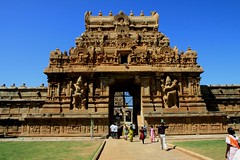 before heading to the Thanjavur Temple Complex, which was right by a bustling street. The entire Thanjavur Temple complex is protected within fortified walls with a moat on the outside – it was the first that we had seen of its kind. Just outside the walls an assortment of vendors stood around selling everything from postcards to jewelry – it felt like a fun-fair was on! The complex’s Gopuram (gateway) is a lovely 3-tiered structure with exquisite carvings; it set the stage for what we were to see within.
before heading to the Thanjavur Temple Complex, which was right by a bustling street. The entire Thanjavur Temple complex is protected within fortified walls with a moat on the outside – it was the first that we had seen of its kind. Just outside the walls an assortment of vendors stood around selling everything from postcards to jewelry – it felt like a fun-fair was on! The complex’s Gopuram (gateway) is a lovely 3-tiered structure with exquisite carvings; it set the stage for what we were to see within.
Describing the grand Brihadeesvara Temple in words is very difficult. The whole monument along with its tall pyramidal Vimana (one 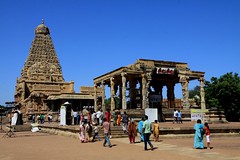 of the tallest in the country!) is absolutely mesmerizing; no wonder it is also known as the Periya Kovil or Big Temple! Moreover, it is set beautifully in a humungous stone courtyard with a dutiful-looking, equally large Nandi sitting before the main entrance. Everything here is so large and overwhelming that it almost feels like the King Rajaraja Chola I set out to build the world’s largest temple complex and actually succeeded! Built in 1010 AD, the temple has completed 1000 yrs this year! A museum, of sorts, in the pillared hallways surrounding the temple, had a wonderful display on the temple’s history and significance. It was a lot of information but armed us enough to explore the place without needing a guide.
of the tallest in the country!) is absolutely mesmerizing; no wonder it is also known as the Periya Kovil or Big Temple! Moreover, it is set beautifully in a humungous stone courtyard with a dutiful-looking, equally large Nandi sitting before the main entrance. Everything here is so large and overwhelming that it almost feels like the King Rajaraja Chola I set out to build the world’s largest temple complex and actually succeeded! Built in 1010 AD, the temple has completed 1000 yrs this year! A museum, of sorts, in the pillared hallways surrounding the temple, had a wonderful display on the temple’s history and significance. It was a lot of information but armed us enough to explore the place without needing a guide.
The main shrine houses a massive Shiva Lingam, which we were able to get a very good look at. A gold-plated snake-hood arches over it and looks absolutely beautiful. The panels on the outer walls of the 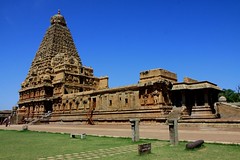 temple have carvings of Bharatanatyam’s 108 Karanas (poses); however, these were never completed by the artisans. Around the main shrine are smaller shrines dedicated to Lord Shiva’s consort, Amman, and children: Subramaniam (aka Kartikeya/Murugan) and Ganesha. Apart from the museum, the pillared hallways bordering the temple complex had many fantastic frescoes, little shrines and idols that were very interesting. We loved exploring all of these but the afternoon heat scorched our bare feet and we literally danced our way around the complex. Next time we are definitely keeping our socks on!
temple have carvings of Bharatanatyam’s 108 Karanas (poses); however, these were never completed by the artisans. Around the main shrine are smaller shrines dedicated to Lord Shiva’s consort, Amman, and children: Subramaniam (aka Kartikeya/Murugan) and Ganesha. Apart from the museum, the pillared hallways bordering the temple complex had many fantastic frescoes, little shrines and idols that were very interesting. We loved exploring all of these but the afternoon heat scorched our bare feet and we literally danced our way around the complex. Next time we are definitely keeping our socks on!
We spent nearly 2 ½ hours in the temple complex and during that time the crowds just kept increasing. We wished we had visited the place very early in the morning (for which we would have had to stay overnight in town) and not on a Sunday. But, thankfully, the complex was large enough to accommodate everyone without making it feel overcrowded.
Apart from the Brihadeesvara Temple, Thanjavur has a Royal Palace with museums within. Sadly, the palace is in complete ruins and is barely worth a visit. Its Darbar Hall, which must have seen its days of glory, has a Mughal-Maratha touch with arched ceilings and some exquisite murals. There were 2 museums within this complex. One had an entry fee of Rs.2 and had a poorly showcased collection of coins, brass-ware and weapons. The access to the 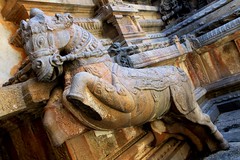 other one was by a filthy gutter and it was located on an upper storey. This one was relatively nicer with paintings, furniture, weapons and decorative stuff belonging to the Maratha rulers. However, the highlight of the Thanjavur Temple Complex was a tiny store selling good quality Thanjavur paintings and brass/bronze idols. Overall, though, the Royal Palace didn’t seem worth the visit at all.
other one was by a filthy gutter and it was located on an upper storey. This one was relatively nicer with paintings, furniture, weapons and decorative stuff belonging to the Maratha rulers. However, the highlight of the Thanjavur Temple Complex was a tiny store selling good quality Thanjavur paintings and brass/bronze idols. Overall, though, the Royal Palace didn’t seem worth the visit at all.
Our final stop before hitting Trichy for the night was the Kallanai Dam (aka Grand Anicut), which is about 25kms east of town. Built in the 1st century AD by a Chola King over the Kaveri river, the dam is considered to be the world’s oldest water-diversion structure that is still in use today! We were over-awed by these facts and were quite keen on seeing it in person. However, when we got there it looked like any other dam especially since it had a fresh coat of paint and looked almost new! Nevertheless it was quite exciting to stand atop one of India’s most ancient building marvels, looking for it to show signs of its true age!


No comments yet.